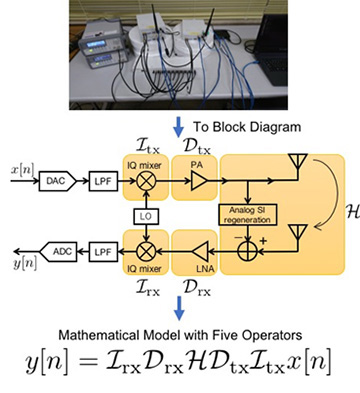
ここからコンテンツです。

Radio interference cancellation with High Precision, High Speed and Low Computational complexity
Promising Applications for Next-generation Wireless Communications By Yuichi Miyaji
The research team of Assistant Professor Miyaji of the Department of Electrical and Electronic Information Engineering at Toyohashi University of Technology has developed a self-interference cancellation filter that is indispensable for the realization of in-band full duplex using the same frequency to transmit and receive simultaneously in wireless communications. The developed self-interference cancellation filter can estimate the distortion caused by radio and the distortion of the radio channel with high accuracy and cancel self-interference. In addition, it can quickly reach the solution of the filter with low computational complexity. It is expected to be applied to next-generation wireless communication technology.
In wireless communication, simultaneous transmission and reception using the same frequency (in-band full duplex) is a very challenging task. Even in the latest wireless communication standard 5G, this in-band full duplex has not been implemented. Currently, it is necessary to divide the time when transmitting and receiving at the same frequency, or to divide the frequency when transmitting and receiving at the same time. It is necessary to separate one of them (time or frequency) because the strength of the radio wave that it emits is up to several hundred million times greater than the strength of the radio wave to receive (self-interference).
The filters that have been developed so far to tackle multiple distortions remove the self-interference with high precision, but also require high computational complexity and take a long time to obtain the solution of the filter. Therefore, the research team of Assistant Professor Miyaji worked on the development of a self-interference cancellation filter that simultaneously satisfies the conditions of high precision, high speed, and low computational complexity.

The first author, Kazuki Komatsu, in the doctoral program (JSPS Research Fellow), explains, "Compared to base stations, low-cost radios such as smartphones have complex distortions, and self-interference cancellation in such devices is a very difficult problem. To solve a complex problem, it is important to boil the problem down to its essence and break it down into multiple smaller problems. We have divided the problem of self-interference cancellation due to the complex distortion of radio equipment into five smaller problems and expressed each using mathematical operators. As a result, it became clear that the solution method of each small problem and the solution method of the big problem which connected them could be derived using five operators and their inverse operators. By applying the derived solution to a filter, we were able to cancel self-interference with higher precision, higher speed, and lower computational complexity than before. The developed filter increases the feasibility of in-band full-duplex communications in small and inexpensive radios such as smartphones."
The research team is planning theoretical performance analysis and field evaluation of the developed self-interference cancellation filter. They also believe that by using the developed filter, it can be applied to wireless networks that cooperate with small mobile objects such as drones. Since it is necessary to recreate the filters periodically according to changes in the radio environment due to movement, we anticipate significant contributions from this technology, which has the features of high precision, high speed, and low calculation complexity.
This research was supported by Hoso Bunka Foundation and Japan Society for the Promotion of Science (JSPS) KAKENHI (JP18K04138, JP19K14979, and JP19J12727).
Reference
Kazuki Komatsu, Yuichi Miyaji, and Hideyuki Uehara (2020). Iterative Nonlinear Self-Interference Cancellation for In-Band Full-Duplex Wireless Communications Under Mixer Imbalance and Amplifier Nonlinearity,
IEEE Transactions on Wireless Communications, DOI:10.1109/TWC.2020.2983407.
高精度、高速、低計算量で電波干渉を除去
次世代無線通信への応用に向けてBy 宮路 祐一
豊橋技術科学大学電気・電子情報工学系の宮路助教らの研究チームは、無線通信において、同じ周波数を使用して同時に送受信する帯域内全二重の実現に不可欠な、自己干渉除去フィルタを開発しました。開発した自己干渉除去フィルタは、無線機によって生じる歪みと無線チャネルの歪みを高精度に推定し、自己干渉を除去することができます。加えて、少ない計算回数で高速にフィルタの解にたどりつくことができます。次世代の無線通信技術への応用が期待されます。
無線通信において、同じ周波数を使用して同時に送受信すること(帯域内全二重)は非常に難しい課題です。最新の無線通信規格5Gにおいても、この帯域内全二重は実現されていません。現状、同じ周波数で送受信する場合は時間を分けるか、同時に送受信する場合は周波数を分ける必要があります。どちらか一方(時間もしくは周波数)を分ける必要があるのは、自身の放射する電波の強さが、受信したい電波の強さに対して最大で数億倍も大きいためです(自己干渉)。
これまでに開発されている複数の歪みを考慮したフィルタは、精度よく自己干渉を除去する一方で、計算回数が多く、フィルタの解を得るために長い時間を要していました。そこで、宮路助教らの研究チームは、高精度、高速、低計算量を同時に満たす自己干渉除去フィルタの開発に取り組みました。
筆頭著者である博士後期課程(JSPS特別研究員)の小松和暉は、「基地局に比べて、スマートフォンなどの低コストの無線機は複雑な歪みを有しており、そのような機器における自己干渉除去は非常に難しい問題です。複雑な問題を解くために、問題の本質を突き詰め、複数の小さな問題へ分解することが重要です。我々は、無線機の複雑な歪みを受けた自己干渉除去という問題を、五つの小問題へ分解し、それぞれを数学の演算子を用いて表現しました。その結果、各小問題の解法や、それを繋ぎ合わせた大問題の解法は、五つの演算子とその逆演算子を使って導出できることを明らかにしました。導出された解法をフィルタに応用することで、従来に比べて、高精度、高速かつ低計算量で自己干渉を除去できました。開発したフィルタによって、スマートフォンなどの小型で安価な無線機における帯域内全二重通信の実現可能性が高まります。」と説明します。
研究チームは、開発した自己干渉除去フィルタの理論的な性能解析やフィールド実験での性能評価を計画しています。また、開発したフィルタを利用することで、ドローンなどの小型移動体が連携する無線ネットワークへの適用が可能だと考えています。これらは、移動による環境の変化に合わせてフィルタを定期的に作り直す必要があるため、高精度、高速、低計算量な特長を併せ持つ本技術の貢献が期待できます。
本研究は、公益財団法人放送文化基金および、文部科学省科学研究費(JP18K04138,JP19K14979, JP19J12727)による支援を受けて実施されました。
Researcher Profile

| Name | Yuichi Miyaji |
|---|---|
| Affiliation | Department of Electrical and Electronic Information Engineering |
| Title | Assistant Professor |
| Fields of Research | Wireless Access / Multi-hop Communications |
ここでコンテンツ終わりです。
